Civil & Environmental Engineering Research
Students in the Civil & Environmental Engineering department have the opportunity to pursue research at both the undergraduate and the graduate levels. A student conducting research may either receive academic credit or receive a stipend. Research stipend is usually provided by the outside agency or organization which is sponsoring the research or by Manhattan University, as part of an established research program, e.g., Jasper summer research scholar/fellow.
Undergraduate Research for Credit
Undergraduate students pursuing a civil engineering degree and interested in research for credit may pursue an independent study course, titled Civil Engineering Projects (CIVL 415). According to the University catalog, this course is suitable for “students of superior ability”. In general, most students participating in undergraduate research for credit have a cumulative GPA of 3.5 or above.
The process starts with a student identifying a faculty member to serve as the mentor on this course. The student works one on one with the faculty member to identify a research topic and then prepares a plan for that research. The scope is usually defined such that the entire work can be concluded in one semester. The student is responsible for meeting with the professor frequently and adhering to the schedule and deliverables. The format of the final product is decided based on the preference of the student and the professor, but is usually in the form of a research report, a poster presentation, or a draft publication.
In recent years, several students have had the opportunity to get their first experience of undergraduate research by taking this course. The resulting posters and publications have been presented at conferences at the regional, national, and international levels. Several students, after taking this course, have opted to pursue full-time research as graduate students – both at Manhattan University, as well as other nationally-ranked institutions.
The following links provide details about some of the students and their research projects. It also includes citations to publications, when applicable, as well as where the student went (graduate school and/or professional career) after leaving Manhattan University.
Examples of recent undergraduate research projects
-
Prediction of Ground Settlements due to Tunneling in Soft Soil
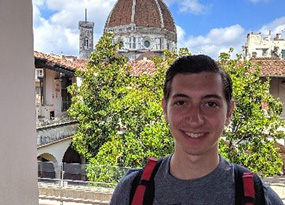
Student: Michael Martello (Class of 2018)
Faculty Advisor: Dr. Evangelia IeronymakiThis research is focused on prediction of ground surface movements during tunneling in soft ground. Data of ground movements from the recently constructed Crossrail tunnels in London have been previously collected and analyzed by the professor and her colleagues at M.I.T. A sensitivity analysis was conducted on these data to evaluate the influence of each parameter on the surface settlement. A preliminary algorithm was developed for estimating the maximum surface settlement from EPBM control parameters (i.e., face pressure, grout pressure and advance rate) and geometric properties, for mechanized tunneling in stiff clay. This empirical tool was further tested on other tunneling projects (Singapore, Bangkok subway tunnels) and the algorithm was modified accordingly to incorporate variations of the stratigraphy. Results of the research would be useful in predicting ground settlement during tunneling. Further refinement of this research will allow predictions on different types of soil and subsurface stratigraphy.
Publication:
Paper in peer-reviewed conference proceedings: “An empirical design tool to predict ground surface response to tunneling with TBM”, Ieronymaki, E. S., Whittle, A. J., and Martello, M. V. Proceedings of the World Tunnel Congress, Dubai, U.A.E., April 2018.
Honor/Recognition for Research:
Michael was inducted to Sigma Xi, the scientific research society, as an associate member in 2018 in recognition of his accomplishments in scientific research.
After Manhattan University:
Michael went on to pursue graduate studies in civil engineering at the Massachusetts Institute of Technology (MIT) as a research assistant, continuing his studies in geotechnical engineering. He also served as an engineering intern at Mueser Rutledge Consulting Engineers in New York.
-
Blast Analysis and Design of Sacrificial and Hardening Structures
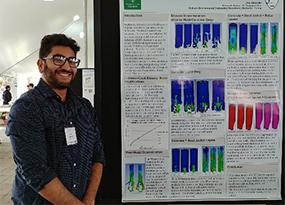
Student: Jithu Alexander (Class of 2018)
Faculty Advisor: Dr. Yongwook Kim, P.E.The objective of this research was to assess the damage to structural members due to blast loading and possible benefits of using sacrificial and hardening structures. Three-dimensional numerical analysis of close-in detonation on a steel column was studied utilizing ANSYS/Autodyn software. Meshes for steel columns were fully-coupled with meshes for air and TNT with material models suitably modified for the specific purposes in the models. Quantitative damage assessment of each steel column was made without any protective layers first, and then, various types of protective measures, including concrete, reinforcement bars and cages, and steel tubes were added to mitigate the damages. Parametric studies were also conducted to understand the effects of material properties, as well as mesh size. Results of the research would be useful in designing better protections for critical structures subjected to potential near-field blast loads.
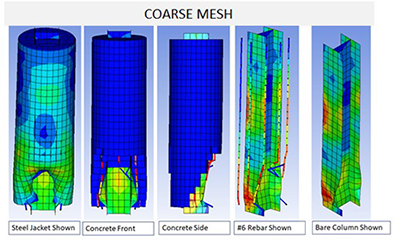
Publications:
Conference Presentation and Abstract:
“Structural Response of Steel Columns Subject to Close-in Detonation with and without Protective Layers” by Kim, Yongwook and Alexander, Jithu, EMI 2018 Conference, sponsored by the Engineering Mechanics Institute of ASCE, MIT, Cambridge, MA, June 2018.
Student Poster at Conference:
“Near-Field Blast Analysis of Wide Flange Steel Columns” by Alexander, Jithu, presented at the CMC Student Poster Competition, EMI 2018 Conference, sponsored by the Engineering Mechanics Institute of ASCE, MIT, Cambridge, MA, June 2018.
After Manhattan University:
Jithu joined Columbia University as a full-time graduate student to pursue a master’s degree in civil engineering with a concentration in structural engineering, starting in Fall 2018. He also worked as an intern in the structural engineering design group of STV, Inc., in New York, NY.
-
Disinfection By-Product Formation in Combined Sewer Overflow under Wet Weather Conditions
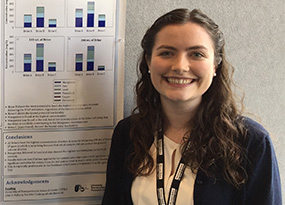
Student: Fiona Dunn (Class of 2017)
Faculty Advisor: Dr. Jessica M. WilsonDisinfection by-products are carcinogenic compounds that form during chemical disinfection of water or wastewater. Wastewater disinfection is challenging for New York City since it is a combined system that treats domestic sewage along with stormwater runoff. During wet weather conditions, the capacity of the sewer system is exceeded and the excess water is discharged directly to the receiving waters. This combined sewer overflow (CSO) can contain elevated levels of bacteria and other contaminants; therefore, different treatment practices may be needed to effectively disinfect the effluent prior to discharge. These different treatment practices may result in higher formation of total DBPs, and a higher risk to downstream users of these waterbodies.
The objective of this work was to assess the formation of DBPs under varied chlorination conditions for different CSOs discharging into NYC waterbodies. Results showed that higher chlorine doses and longer contact times were needed for effective disinfection, and that higher total DBPs were formed under the elevated doses. Additionally, the chemistry of the effluent was an important driver for the types of DBPs that formed, suggesting that monitoring effluent quality is necessary to determine overall risk to public health. This work shows that CSO effluent containing DBPs can magnify public health risk, and that the potential risk will increase as wastewater is becoming more important in sustainable water supplies.
Publication:
Published conference proceedings:
Dunn, F.B., Wilson, J.M. “Disinfection by-product formation in combined sewer overflow effluent under wet weather conditions.” Proceedings of the World Environmental and Water Resources Congress 2018: Groundwater, Sustainability, and Hydro-Climate/Climate Change, Minneapolis, MN, 2018, 64-75. doi: 10.1061/9780784481417.006.
Honor/Recognition for Research:
Fiona was awarded the Lawrence Eckenfelder Award for Excellence in Environmental Engineering and the John D. Mahony Medal for Undergraduate Student Research. She also received the Hazen and Sayer Walter B. Sinnott Scholarship and an Honorable Mention for the Barry Goldwater Scholarship. Fiona was awarded 1st place in the student poster competition at the New York State Annual Water Works Association (AWWA) Conference in 2016. She was then sent to the national AWWA Annual Conference and Exhibition (ACE) in Chicago, IL to present her research and compete in the national poster competition.
After Manhattan University:
Fiona went on to pursue a PhD in civil and environmental engineering at NYU Tandon School of Engineering. She has continued to conduct research in environmental engineering and is currently investigating the sunlight inactivation of antibiotic resistant bacteria. Fiona was recently awarded a National Science Foundation Graduate Research Fellowship.
-
Numerical Study of Torpedo Anchor Penetration in Granular Media
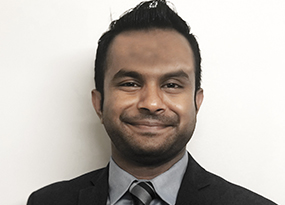
Student: Muhammad Baksh (Class of 2017)
Faculty Advisor: Dr. Mehdi OmidvarIn this research, a numerical model, comprising of an explicit dynamics finite element hydrocode (ANSYS/Autodyn) was utilized to simulate torpedo anchor installation in a sandy soil deposit. Torpedo anchors are increasingly used as foundations for offshore oil platforms in deep water oil and gas exploration. Anchors are allowed to fall under gravity in seawater to impact and penetrate the seabed. Metal chains connect anchors to the oil platform. In this research, the behavior of the soil was mathematically simulated by using laboratory experiments on soil samples. The resulting model consisted of an equation that simulates wave propagation in the soil, along with equations that model the failure of soils. The numerical model incorporates state-of-the-art features in numerical modeling to accommodate dynamic events such as torpedo impact on the seabed. The mathematical model and the numerical simulations were validated by comparison against laboratory torpedo impact tests in synthetic transparent soil models, which the faculty member conducted in the geotechnical engineering lab at New York University (NYU). Comparison of the results showed that the simulations are capable of capturing the salient features of soil kinematics during torpedo anchor installation. An example of computer simulation of torpedo anchor installation is shown in the figure.
Results of the research can be useful in predicting penetration characteristics of torpedo anchors, and to design torpedo anchors for optimal performance. The model utilized here can be developed further to predict anchor pullout capacity of offshore anchors.
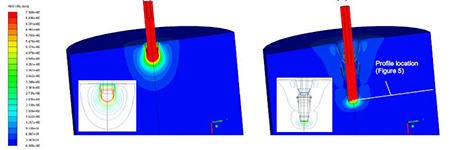
Publication:
Paper in peer-reviewed conference proceedings: “Hydrocode Modeling of Torpedo Anchor Installation in Soils”, Omidvar, M., Baskh, M. A., and De, A. Proceedings of ICFEE 2018, ASCE, doi.org/10.1061/9780784481578.011, 2018.
After Manhattan University:
Muhammad is employed full-time as an Engineer at McLaren Engineering Group in New York City working on a variety of waterfront revitalization projects throughout New York Harbor while pursuing his master’s degree at Manhattan University part-time.
-
Empirical Investigation of the Impact of Urbanization on Baseflow in Streams in Connecticut Watersheds
Student: Samantha Corrado (Class of 2016)
Faculty Advisor: Dr. Kirk Barrett P.E.This research investigated the existence of a correlation between increased percent imperviousness of a watershed as urbanization occurs and the baseflow in streams. In theory, an increase in percent imperviousness decreases the baseflow in streams. Historical streamflow data was obtained from the United States Geological Survey and county population data was obtained from the United States Census Bureau. Population density was mathematically related to percent imperviousness. To reduce variability within this study, only gauges in the state of Connecticut were considered as the entirety of Connecticut is located within the New England physiographic province.
Seventeen stream gauges in counties showing signs of urbanization were selected based on the criteria that drainage areas were no larger than 400 square miles and lengths of record were at least 25 years. The Eckhart digital filtering method was used to separate out baseflow, and three baseflow metrics were calculated for each water year: total flow, baseflow, and baseflow index.
A statistically significant relationship between increase in percent imperviousness and decrease in baseflow was not observed for any of the 17 gauges. Therefore, urbanization in Connecticut does not appear to have a negative effect, if any effect, on baseflow in streams. A statistically significant positive correlation was observed in four gauges. This relative increase in baseflow is likely due to anthropogenic urban recharge; however, the exact cause is not discoverable at this level of analysis. An understanding of the impacts of urbanization on both surface water and groundwater sources is imperative in water resource management decisions.
Publication:
Conference Presentation:
“A Historical Analysis of the Relationship between Urbanization and Baseflow in Streams in Connecticut”, by Corrado, S. and Barrett, K. Annual Conference of the NY Section of the American Waterworks Association, 2016.
After Manhattan University:
After graduation, Samantha joined Georgia Institute of Technology (Georgia Tech) in Atlanta, Georgia as a full-time graduate student. She received a masters degree in Civil Engineering, specializing in Water Resources Engineering and then pursued a masters and Ph.D. in Aerospace Engineering.